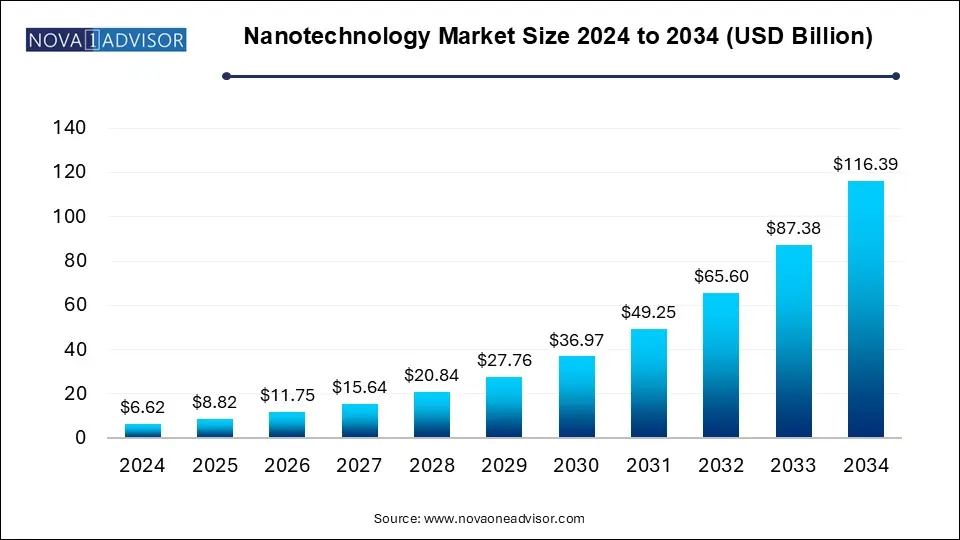The nanotechnology market size was exhibited at USD 6.62 billion in 2024 and is projected to hit around USD 116.39 billion by 2034, growing at a CAGR of 33.2% during the forecast period 2025 to 2034.

| Report Coverage | Details |
| Market Size in 2025 | USD 8.82 Billion |
| Market Size by 2034 | USD 116.39 Billion |
| Growth Rate From 2025 to 2034 | CAGR of 33.2% |
| Base Year | 2024 |
| Forecast Period | 2025-2034 |
| Segments Covered | Type, Application, Region |
| Market Analysis (Terms Used) | Value (US$ Million/Billion) or (Volume/Units) |
| Regional scope | North America; Europe; Asia Pacific; Latin America; MEA |
| Key Companies Profiled | Nanonics Imaging Ltd.; ANP CORPORATION; Bruker Corporation; Fujitsu Limited; Thermo Fisher Scientific Inc.; Kleindiek Nanotechnik GmbH; eSpin Technologies, Inc.; Altairnano; Bayer AG; Infineon Technologies AG |
Nanotechnology involves the study of nanodevices, with their versatile applications spanning various scientific domains, including chemistry, biomedical science, mechanics, and materials science. Within the market, there is a broad scope involving the creation and utilization of physical, chemical, and biological systems and devices, operating within a scale spectrum ranging from single atoms or molecules up to approximately 100 nanometers. This field can potentially revolutionize industries by harnessing the unique properties and capabilities found at the nanoscale.
The increased adoption of nanotechnology in medical diagnosis and imaging, and continuous technological advancements in nanotech devices play a key role in propelling market expansion. This trend emphasizes the potential for nanotechnology to revolutionize medical practices by enabling more precise and efficient diagnostic procedures. Moreover, the growth of the market is further fueled by the substantial support and research and development (R&D) funding provided by government organizations. Nanotechnology is enabling the creation of advanced materials with enhanced properties.
Nanotechnology involves building complex structures at the molecular or atomic level to produce high-quality, high-performing goods at reduced costs. It is a cutting-edge and efficient technology involved across diverse industrial sectors, including transportation, manufacturing, agriculture, and pharmaceutical. The global nanotechnology market is anticipated to grow due to the increasing use of nanomaterials in diverse end-use verticals, such as healthcare, electronics, aerospace, and textiles. Furthermore, nanotechnology enables the creation of smaller transistors, memory devices, and sensors, contributing to the continued advancement of electronics and computing.
The nanodevice segment led the market in 2024, accounting for over 59.0% of global revenue. Nanodevices have shown significant potential in healthcare and medical applications, such as targeted drug delivery, imaging, diagnostics, and regenerative medicine. These applications have garnered substantial interest and investment, leading to a larger market share for the segment. Furthermore, the electronics industry has been a major driver of nanodevice adoption, with applications such as smaller and more efficient transistors, memory devices, and sensors. As technology continues miniaturizing, nanodevices become indispensable for maintaining and improving device performance.
The nanosensor segment is estimated to grow significantly over the forecast period. Nanosensors are a crucial nanotechnology component, enabling the detection and measurement of various parameters at the nanoscale. Their applications range from medical diagnostics and environmental monitoring to electronics and consumer goods. The rapid advancement of nanotechnology has led to the development of increasingly sophisticated nanosensors with improved sensitivity, selectivity, and miniaturization, which has expanded their usability across diverse industries.
The healthcare & pharmaceuticals segment led the market in 2024, accounting for over 26% share of the global revenue. The remarkable upsurge in adopting nanotechnology across diverse medical applications, including surgical nano-robots, nano-diagnostics, nano-biosensors, cell repair, imaging, and targeted drug delivery, stands as the central driving force propelling the robust growth of the medical segment. Furthermore, the growing prevalence of chronic diseases globally and the rising adoption of surgical procedures among patients is anticipated to fuel the demand for nanotechnology in producing a range of surgical tools and equipment.
The automobile segment is estimated to grow significantly over the forecast period. Integrating nanotechnology into the automotive industry can bring numerous benefits, including improved materials, enhanced energy efficiency, safety advancements, and innovative functionalities. Furthermore, nanotechnology has enabled the development of advanced materials with enhanced properties, such as strength, durability, and lightweight characteristics. These materials can be used in vehicle construction to improve fuel efficiency, safety, and overall performance.
North America dominated the market in 2024, accounting for over 38% share of the global revenue owing to increasing research and development (R&D) expenditure by governments in the region, which is leading to increased demand for nanotechnology-based innovative and advanced solutions in various end-use sectors. In addition, growing healthcare, IT, and manufacturing industries in countries such as Canada and the U.S. are expected to contribute to the market growth during the forecast period. For instance, in August 2023, the University at Albany unveiled the establishment of the College of Nanotechnology, Science, and Engineering. This newly expanded academic division enhances UAlbany's standing as a frontrunner in engineering, nanotechnology, semiconductor research, computer science, and artificial intelligence.
Asia Pacific is anticipated to register the fastest CAGR over the forecast period. The Asia Pacific region's increasing focus on developing its energy and power sector through government investments is anticipated to create a facilitative environment for the demand for nanomaterials over the forecast period. Notably, countries such as China, India, South Korea, and Japan are witnessing substantial demand for nanomaterials, attributed to their extensive manufacturing capacities across various industries. In addition, the region's favorable industrial policies, coupled with factors such as cost-effective labor and accessible production resources, are fostering a surge in Foreign Direct Investments (FDIs). This rise in investment is poised to bolster the manufacturing sector within the Asia Pacific region significantly, hence driving the utilization of nanomaterials across various applications.
This report forecasts revenue growth at country levels and provides an analysis of the latest industry trends in each of the sub-segments from 2021 to 2034. For this study, Nova one advisor, Inc. has segmented the nanotechnology market
By Type
By Application
By Regional